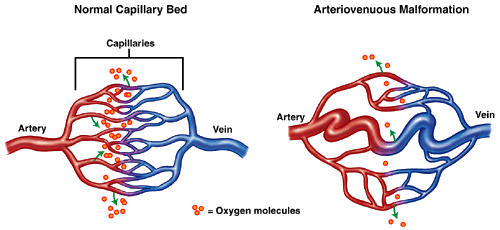Arterio-Venous Malformations
What is an arterio-venous malformation (AVM)?
An arterio-venous malformation is an abnormal tangle of blood vessels.
Where can an AVM occur?
An AVM can occur anywhere in the body including the brain or spinal cord.
How is an AVM different from normal blood vessels?
Normal blood vessels have the following architecture
arteries —> capillaries —> veins
AVM is a tangle of blood vessels with the principal abnormality being direct communication between arteries and veins without intervening capillaries
arteries —> veins
Why is a brain or spinal cord AVM dangerous?
AVM’s can cause damage to the brain or spinal cord in one of three ways.
a) Bleeding
b) Pressing on normal brain or spinal cord tissue
c) Stealing blood from normal brain or spinal cord tissue
Why do AVM’s bleed?
The veins of an AVM are directly exposed to high pressure from the feeding artery as there are no intervening capillaries. The veins are thin walled and are not capable of handling this pressure. This can result in a rupture of the veins.
What causes AVM’s?
It is not fully understood as to what causes AVM’s.
What are common symptoms of an AVM?
1) Headache
2) Seizures
3) Stroke symptoms (weakness, numbness, slurred speech, visual problems)
When is an AVM diagnosed?
An AVM is usually diagnosed between ages 20 and 40 years either because it causes symptoms or because it was discovered incidentally when a patient undergoes a scan for an unrelated problem.
How is an AVM diagnosed?
An AVM can be diagnosed by various forms of brain imaging.
a) CT scan
b) MRI
c) Cerebral angiogram
How is an AVM treated?
There are currently three types of treatments available
a) Endovascular embolization
b) Surgical excision
c) Radiation
Sometimes a combination of the above treatments is necessary.
What are the risks of not treating an AVM?
AVM’s can remain silent in a majority of people. However the risk of bleeding from an AVM increases with age.
Approximate risk of bleeding from an AVM in years after diagnosis:
10 years —33.5%
20 years —55.8%
30 years —70.6%
40 years —80.3%
50 years —86.8%
Should i get my AVM treated?
This decision is best made after a detailed discussion with a team of experts who regularly treat this condition.
Where should i get my AVM treated?
AVM’s are complex problems and require an expert team of physicians to obtain the best possible outcome.
For a list of members of this society who treat AVM’s click here.
More information:
http://www.patientpower.info/player/bens-friends-avm-survivors-network/#
Support groups:
http://neurosurgery.mgh.harvard.edu/interventional/avmspt.htm
Disclaimer: The content of this website is produced and made available for informational and educational purposes only and does not constitute, and should not be used as a substitute for, medical advice, diagnosis, or treatment. Patients and other members of the general public should always seek the advice of a physician or other qualified healthcare professional regarding personal health or medical conditions.

